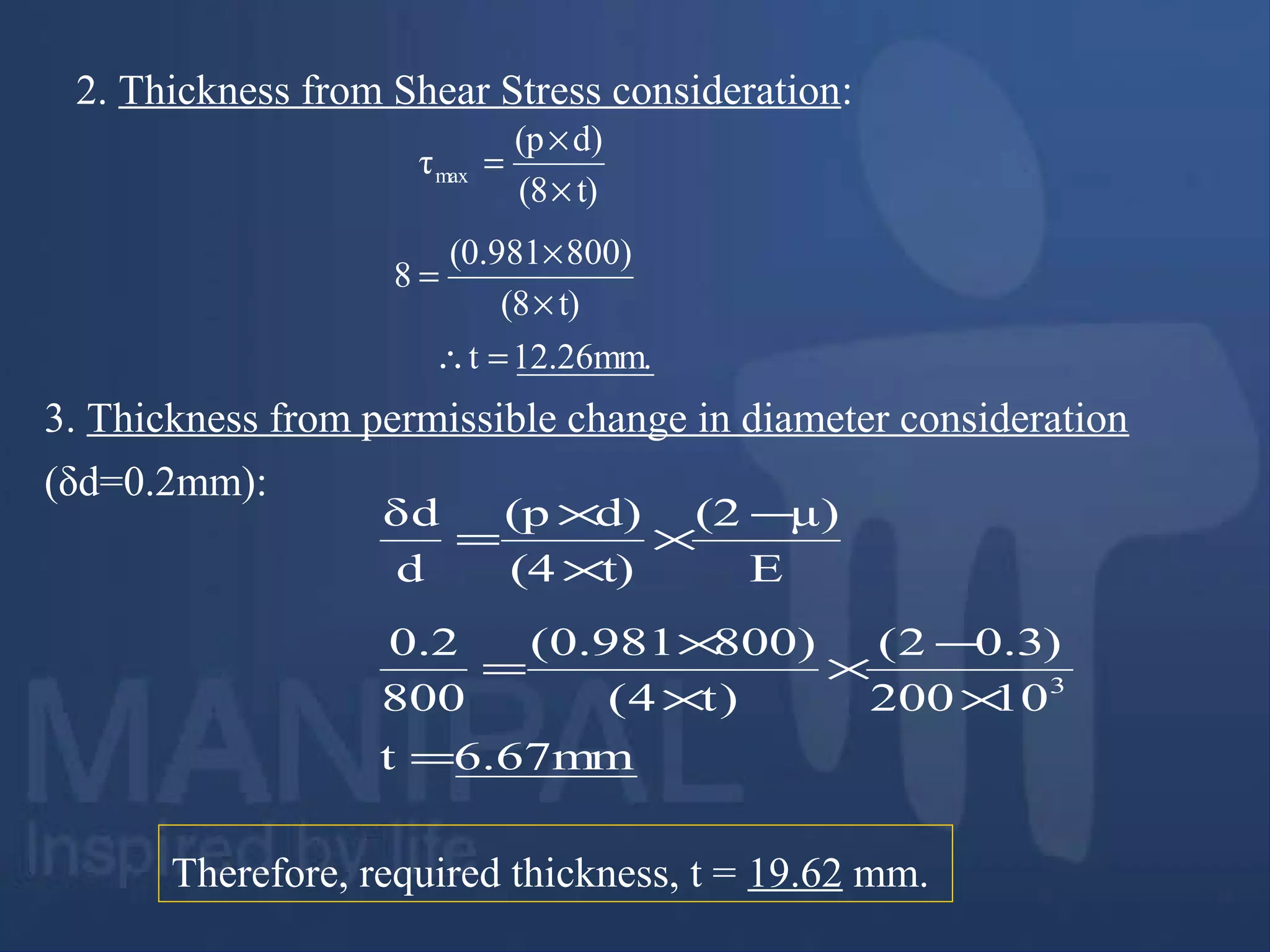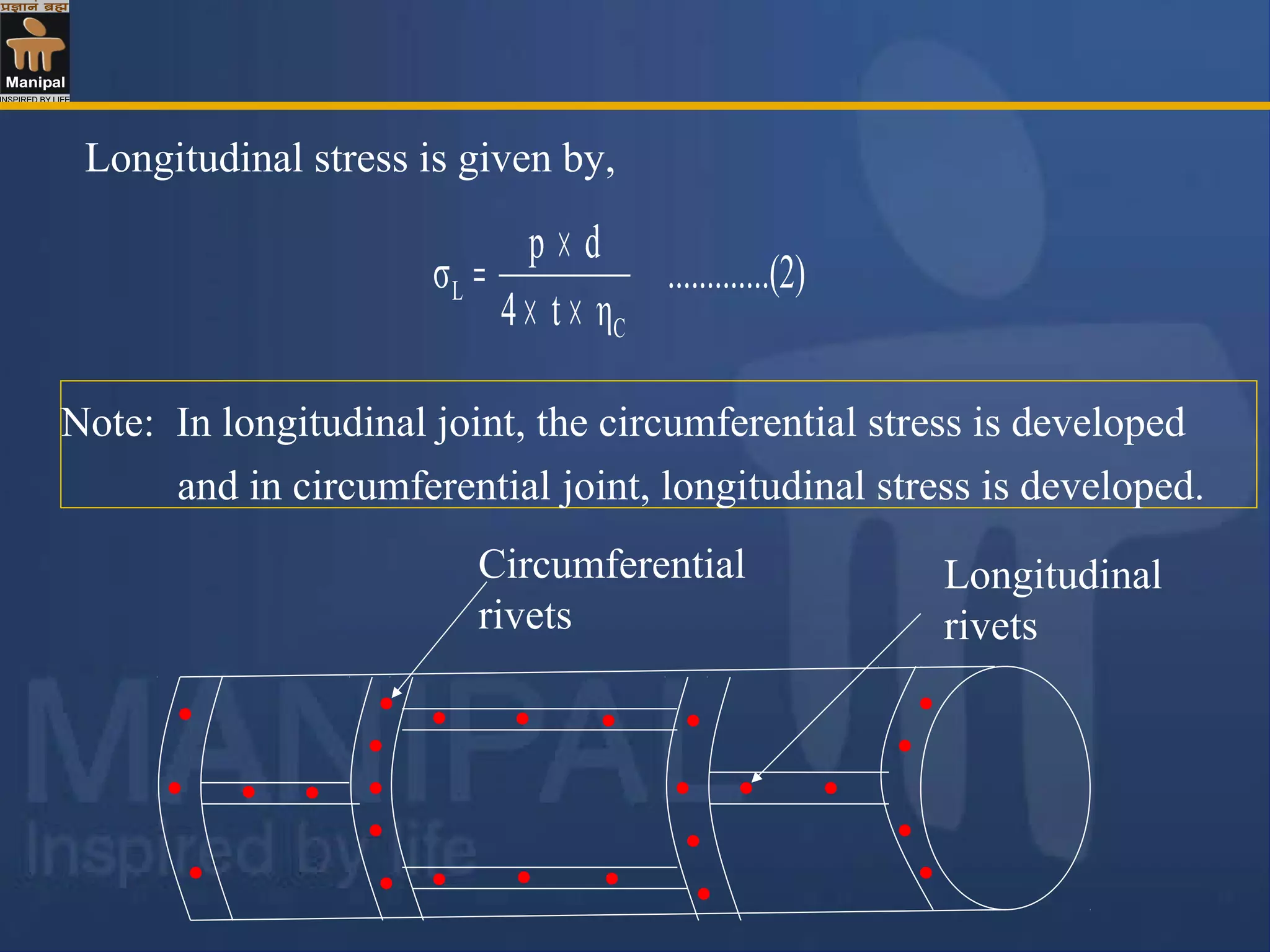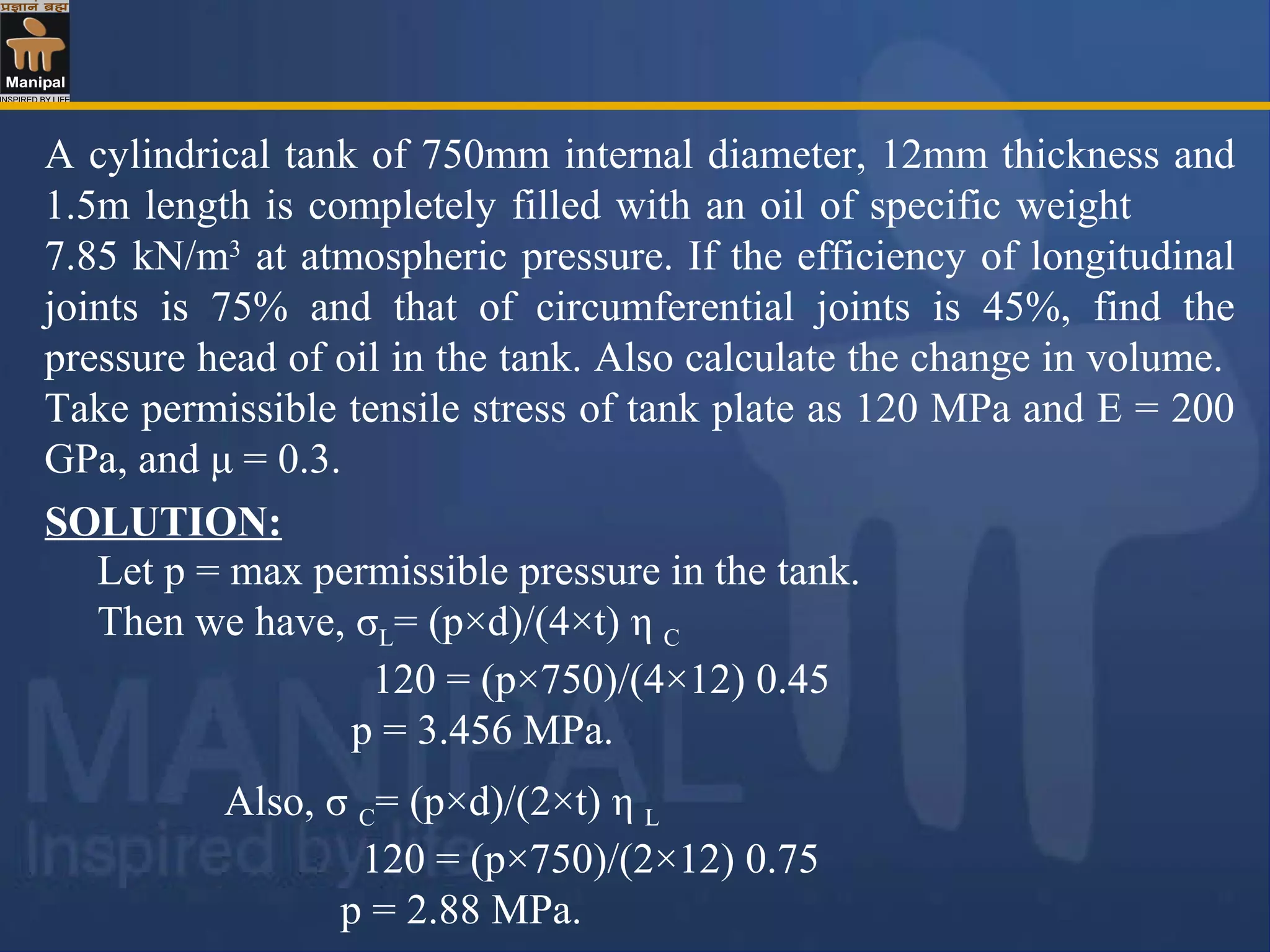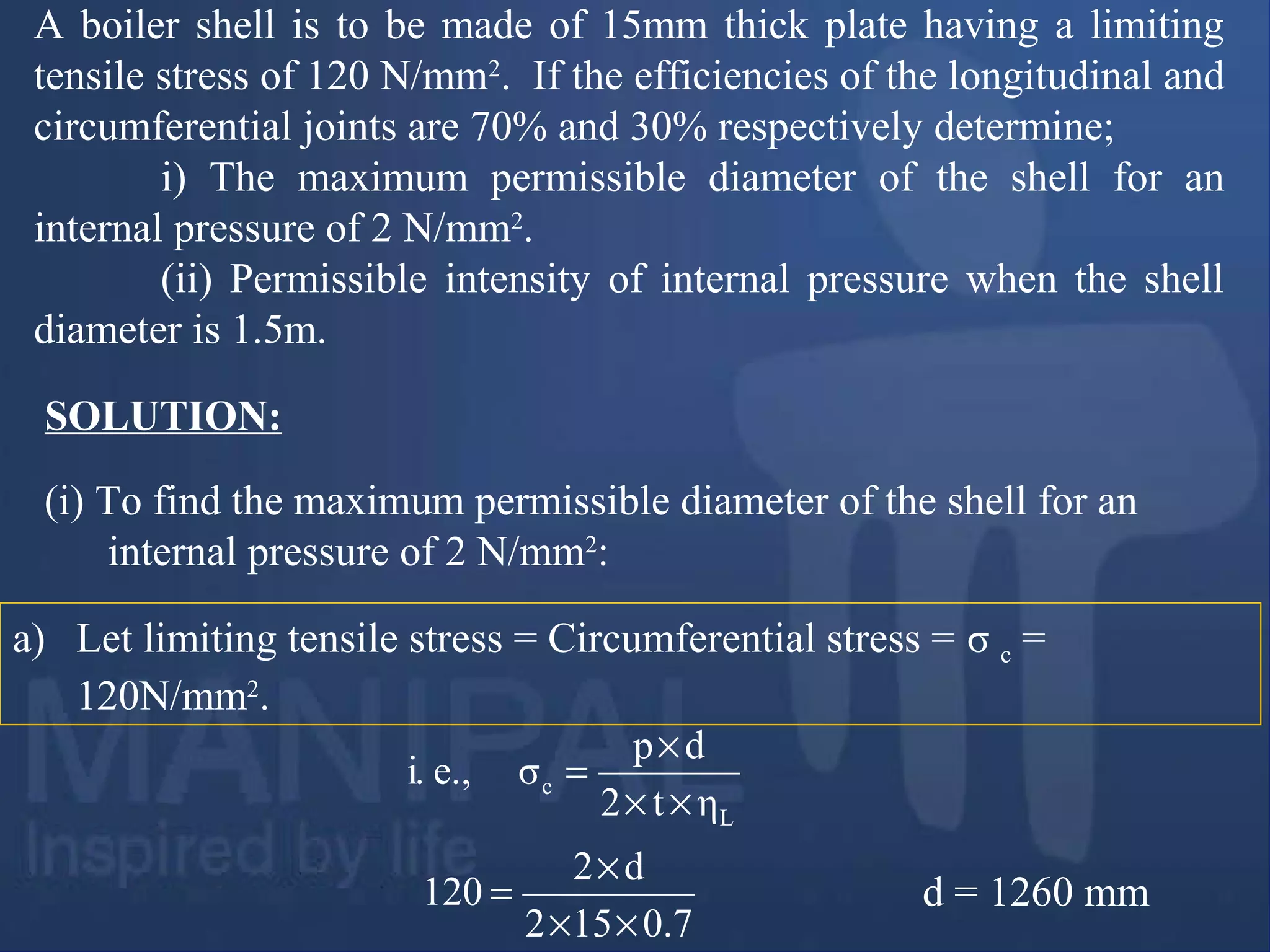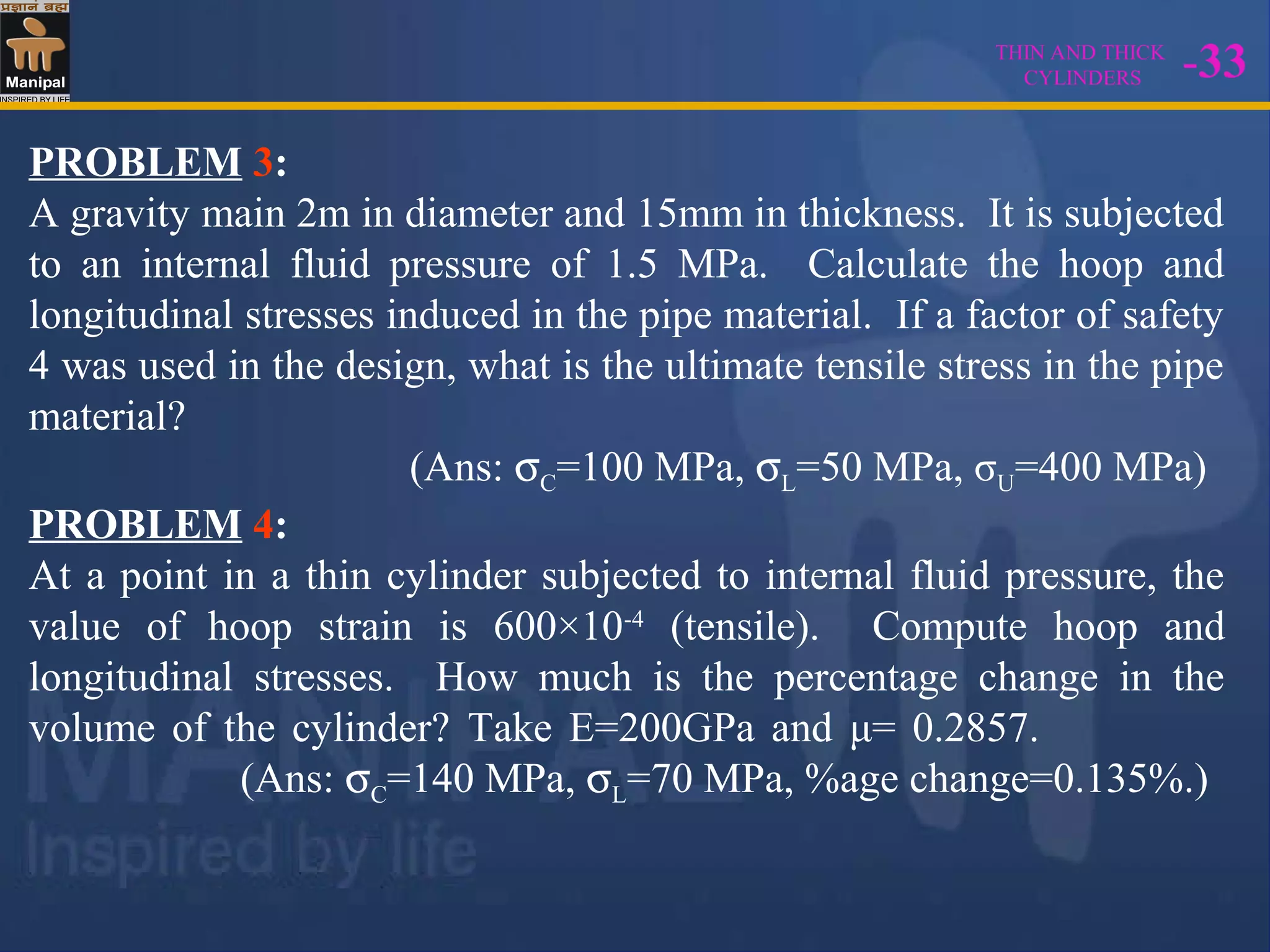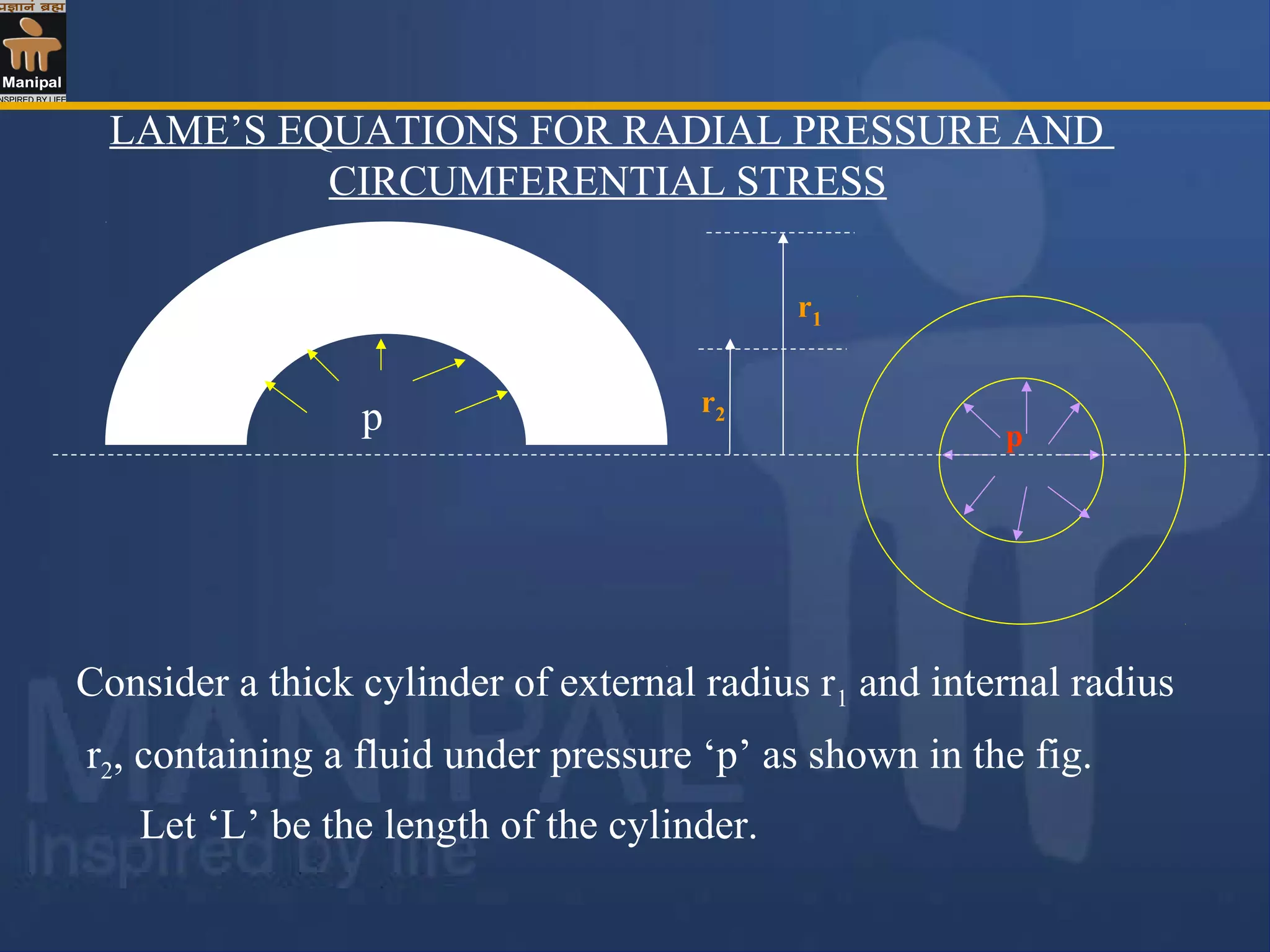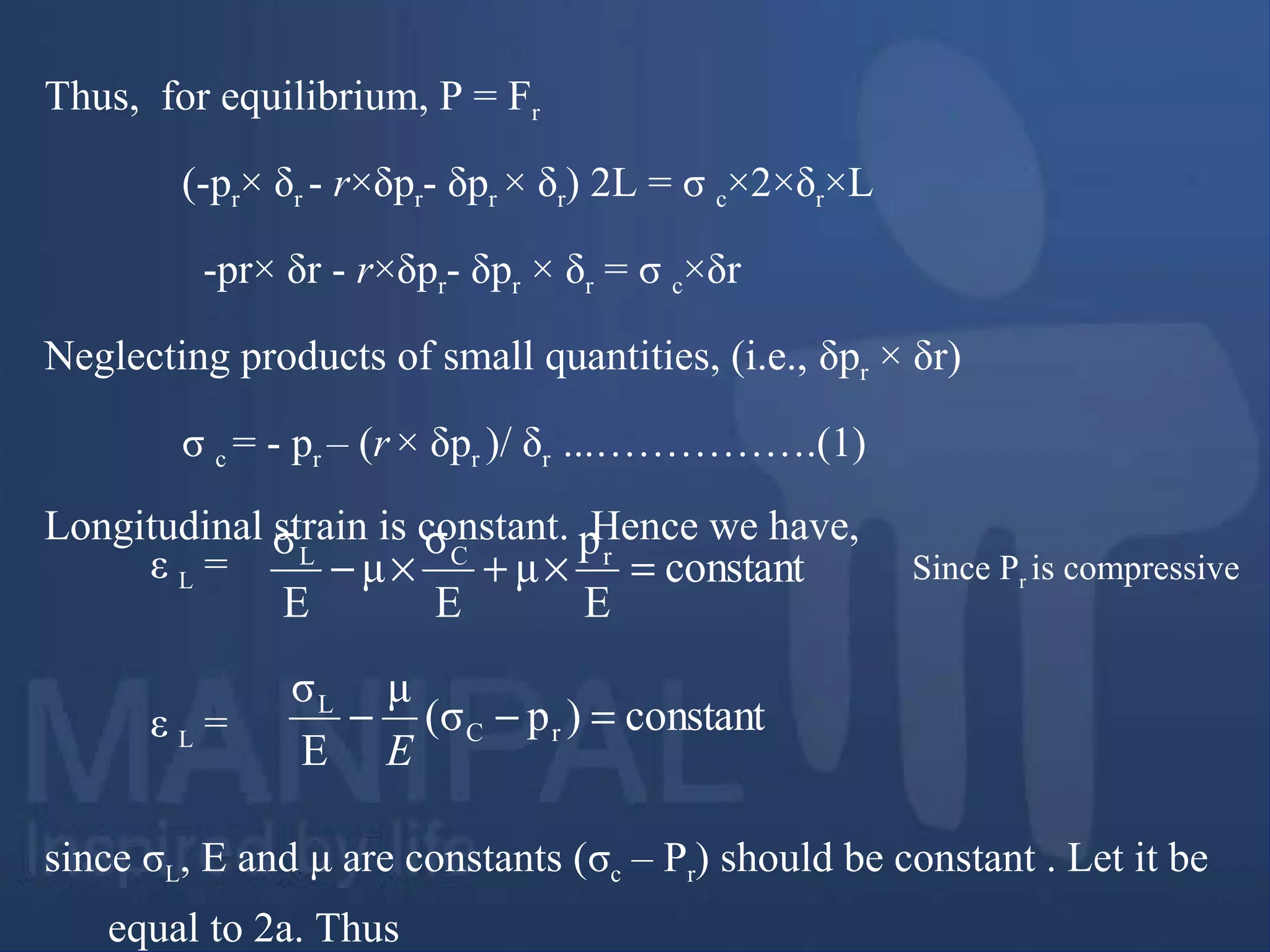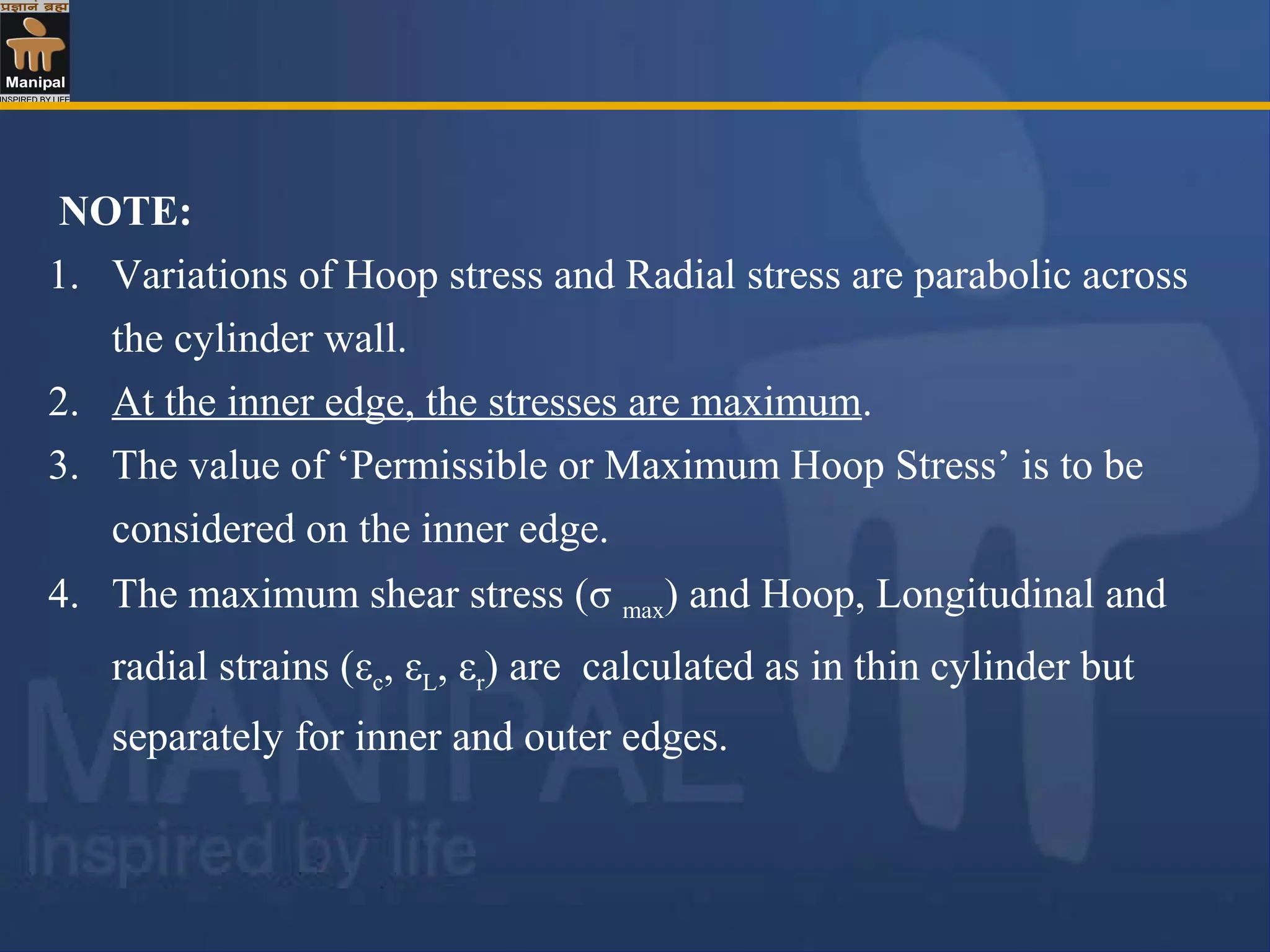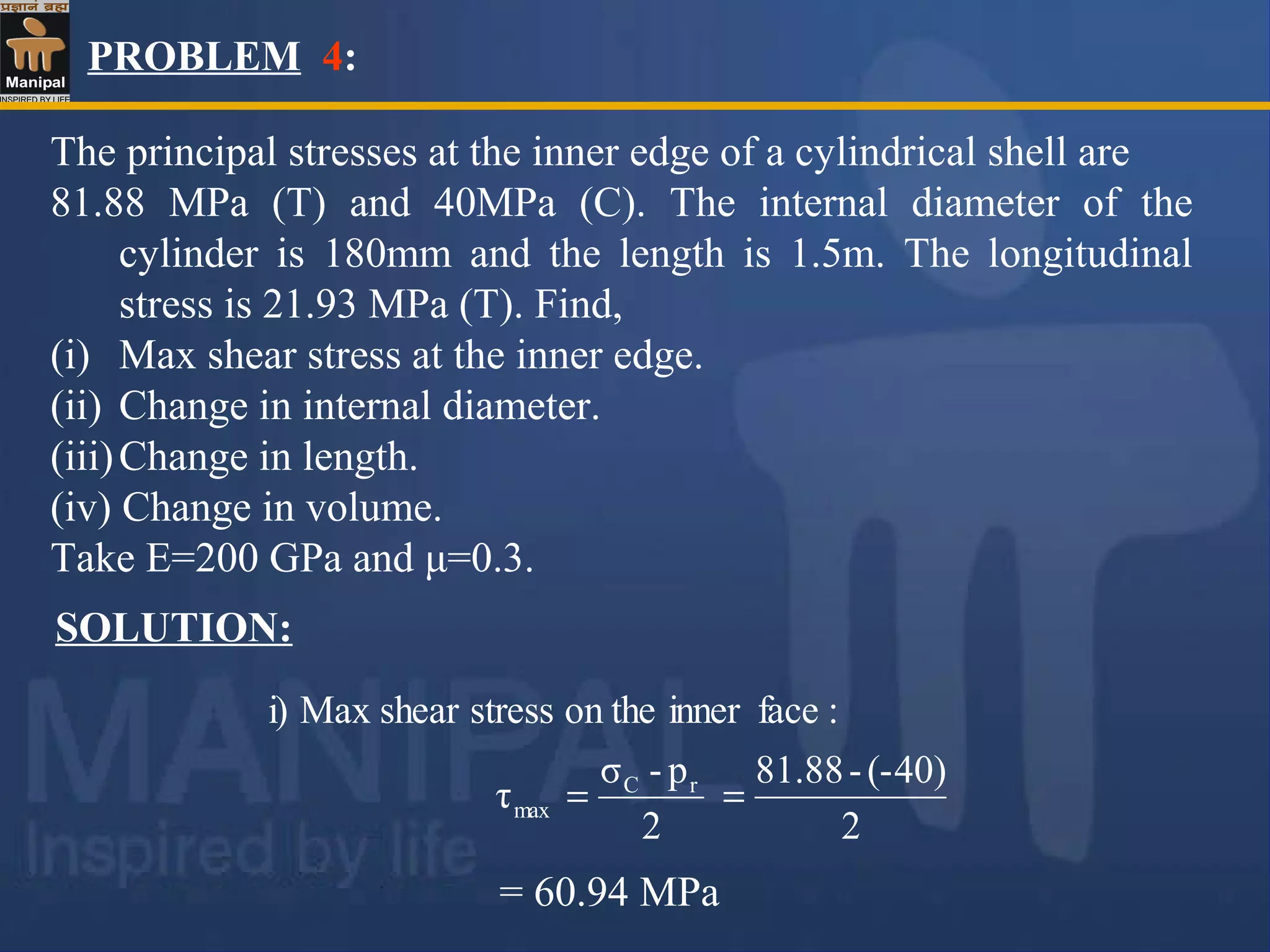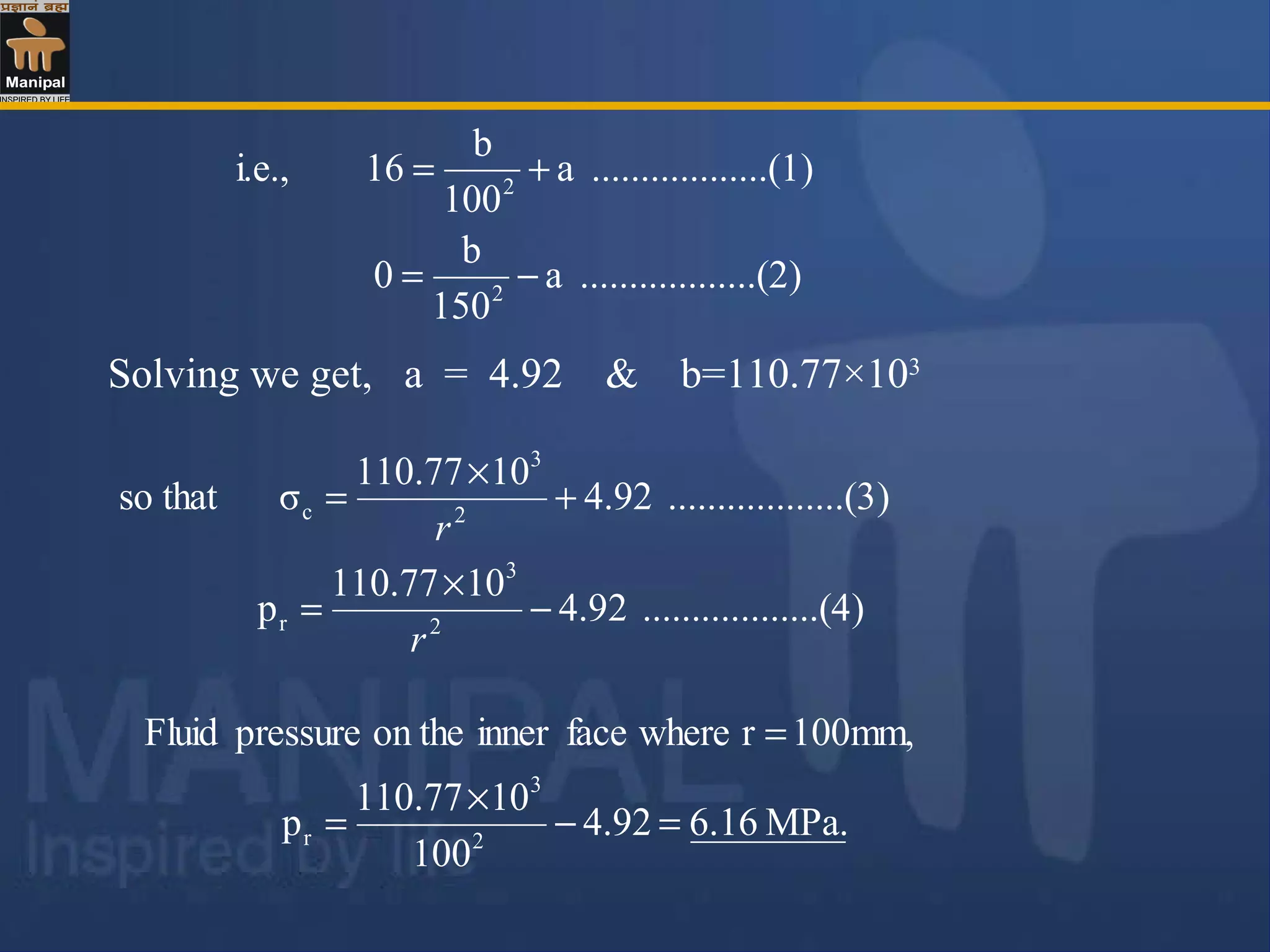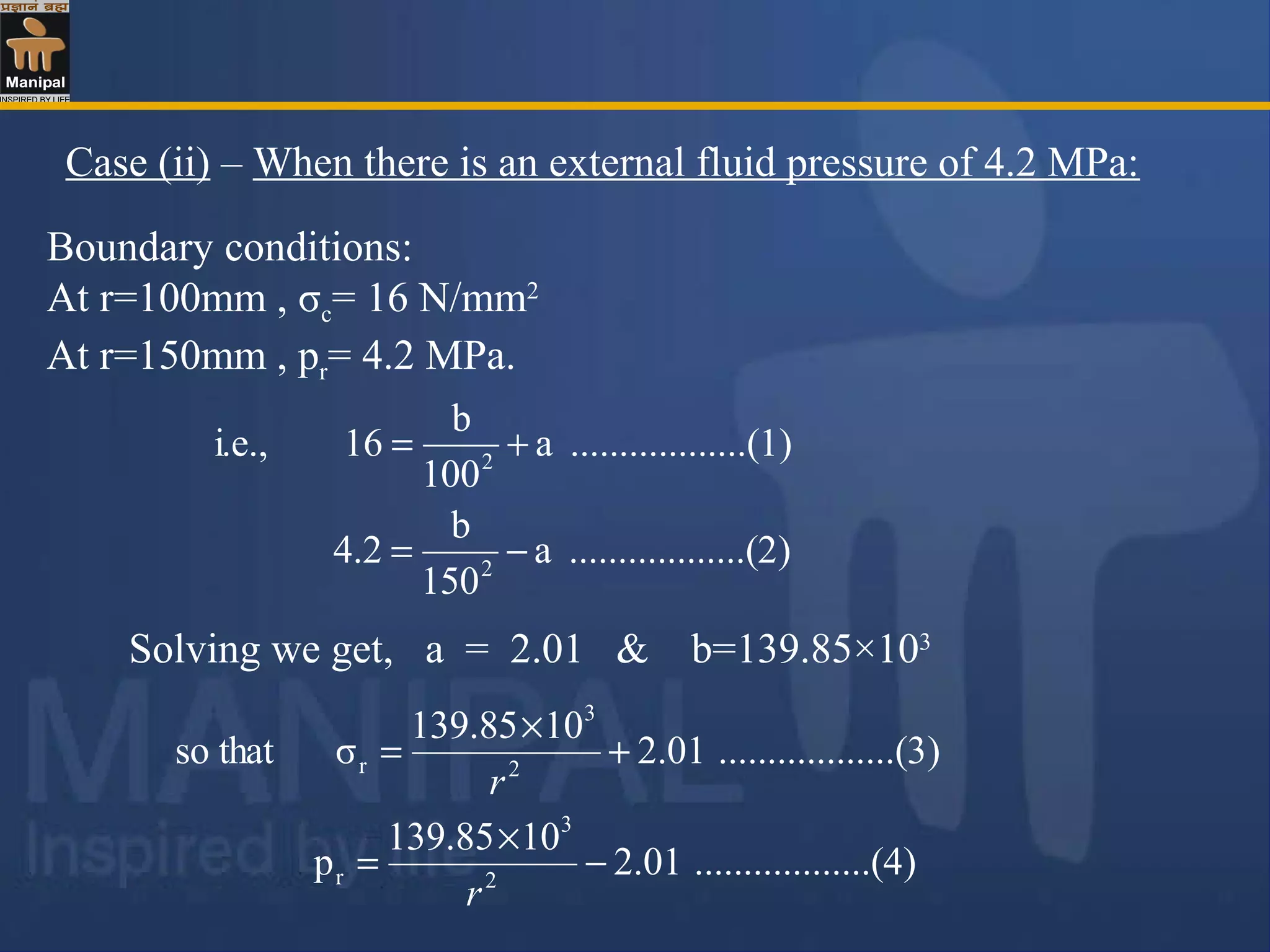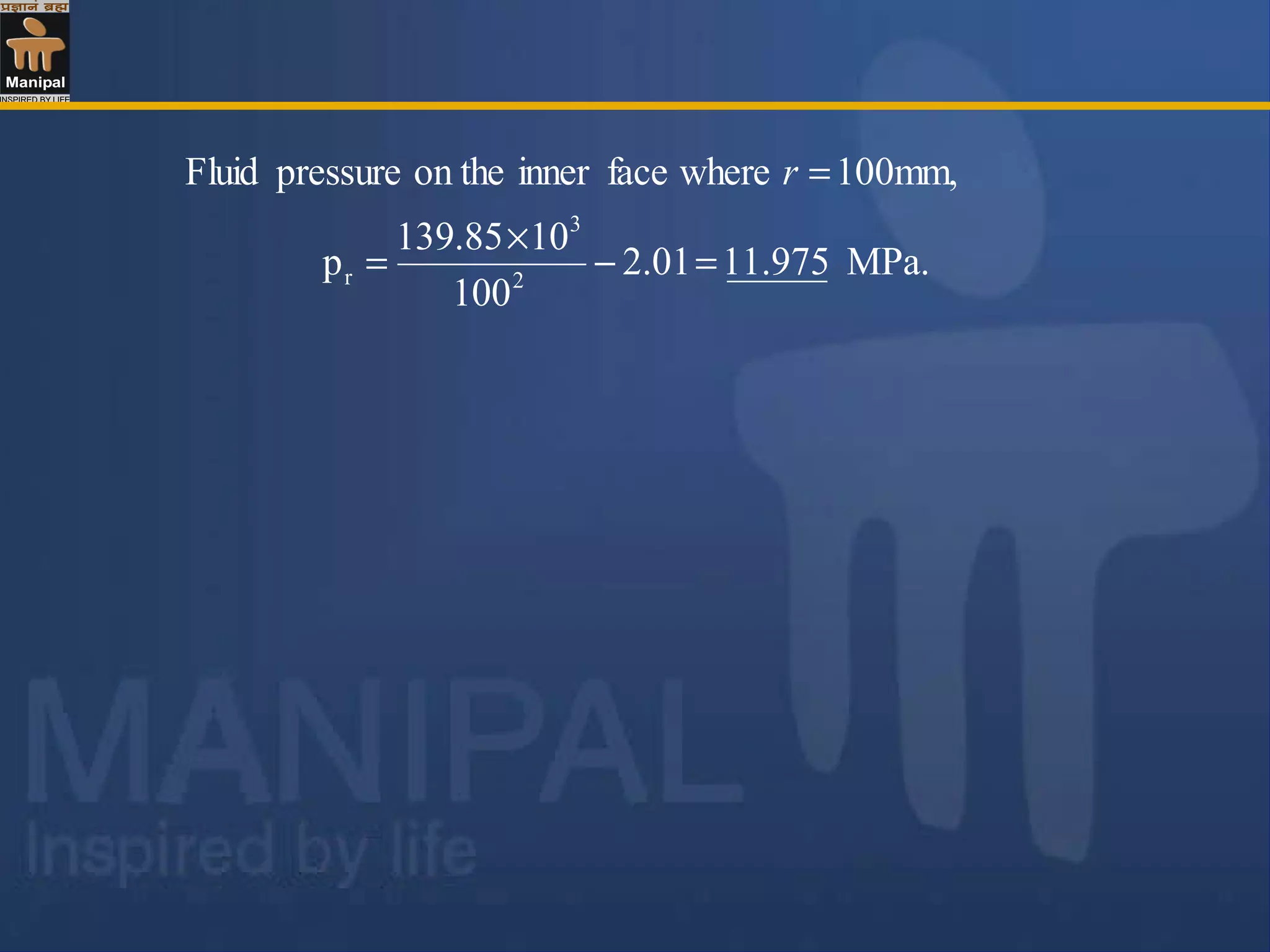1. Cylinders are commonly used in engineering to transport or store fluids and are subjected to internal fluid pressures. This induces three stresses on the cylinder wall - circumferential, longitudinal, and radial.
2. For thin cylinders where the wall thickness is less than 1/20 the diameter, the radial stress can be neglected. Equations are derived to calculate the circumferential and longitudinal stresses based on the internal pressure, diameter, and wall thickness.
3. Sample problems are worked out applying the equations to example thin-walled cylinders under internal pressure, finding stresses, strains, and changes in dimensions.
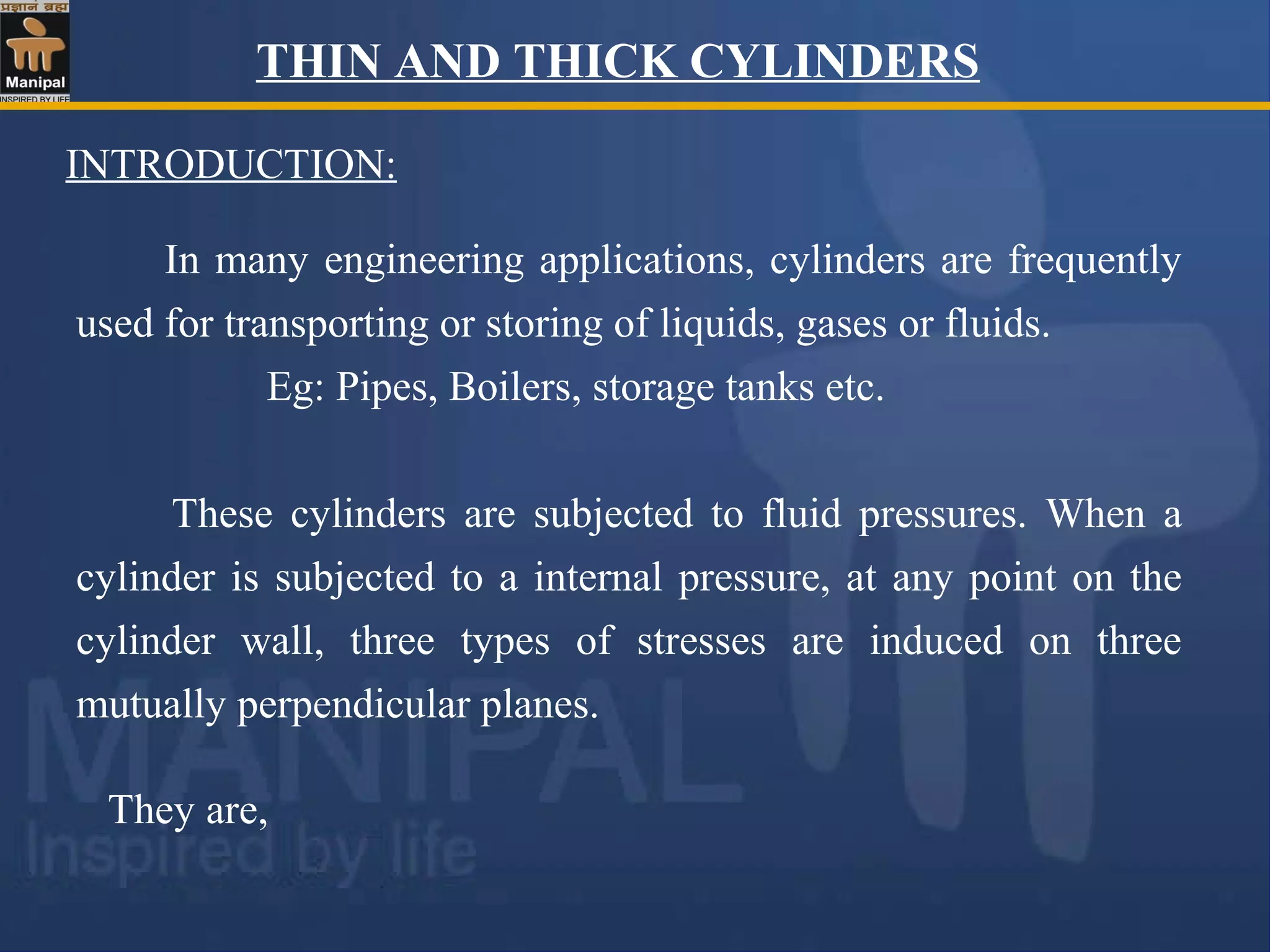
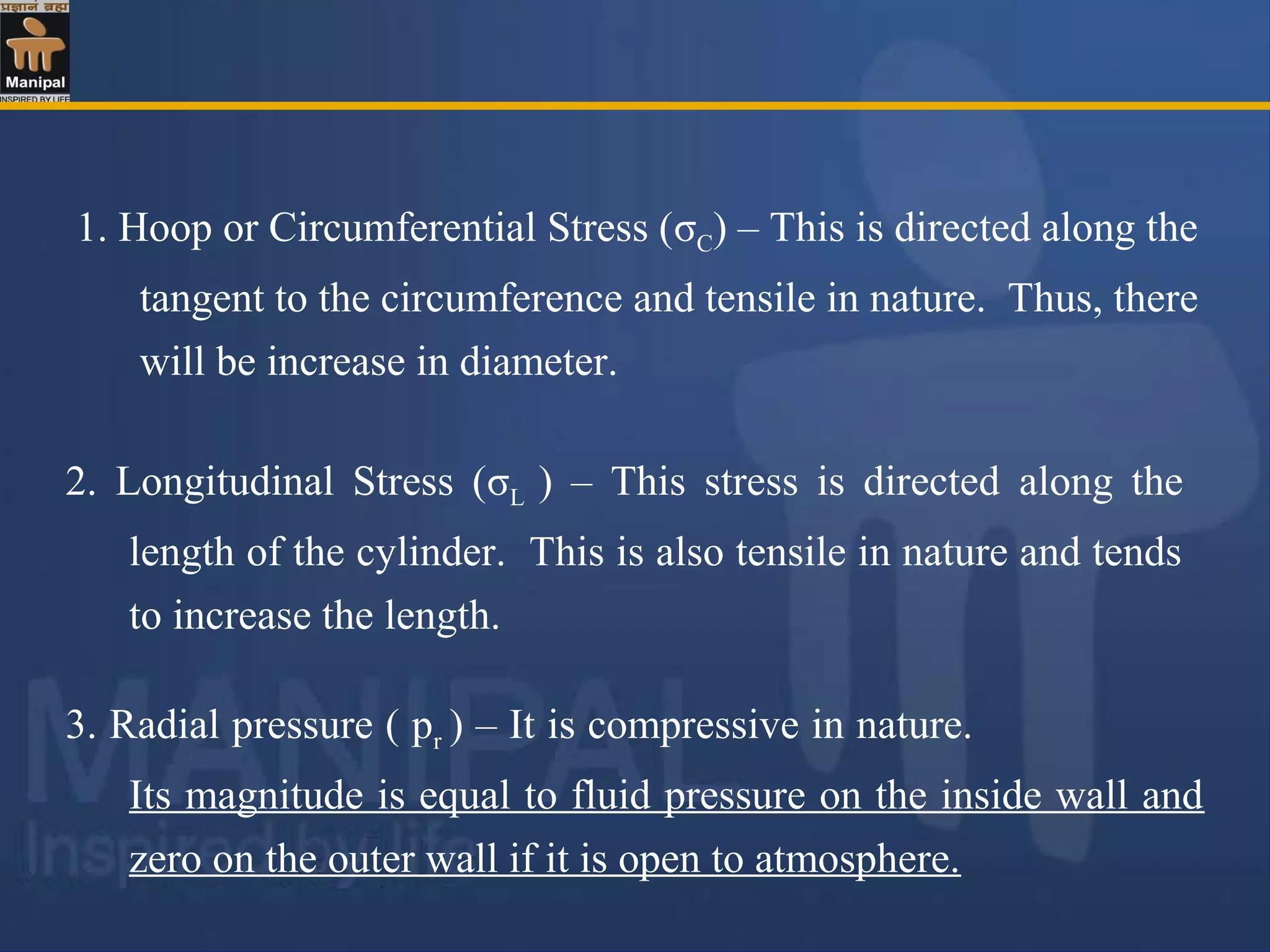



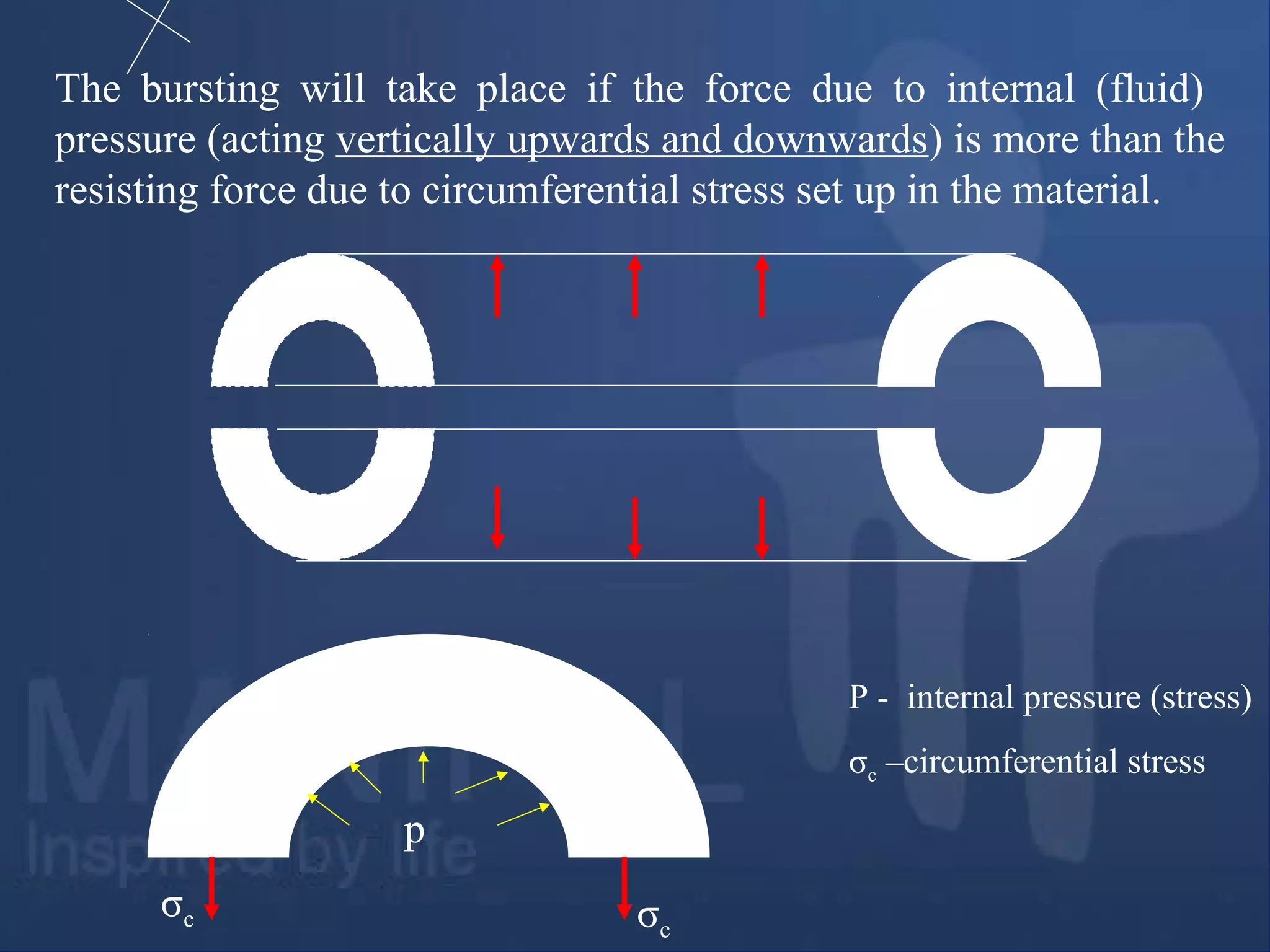
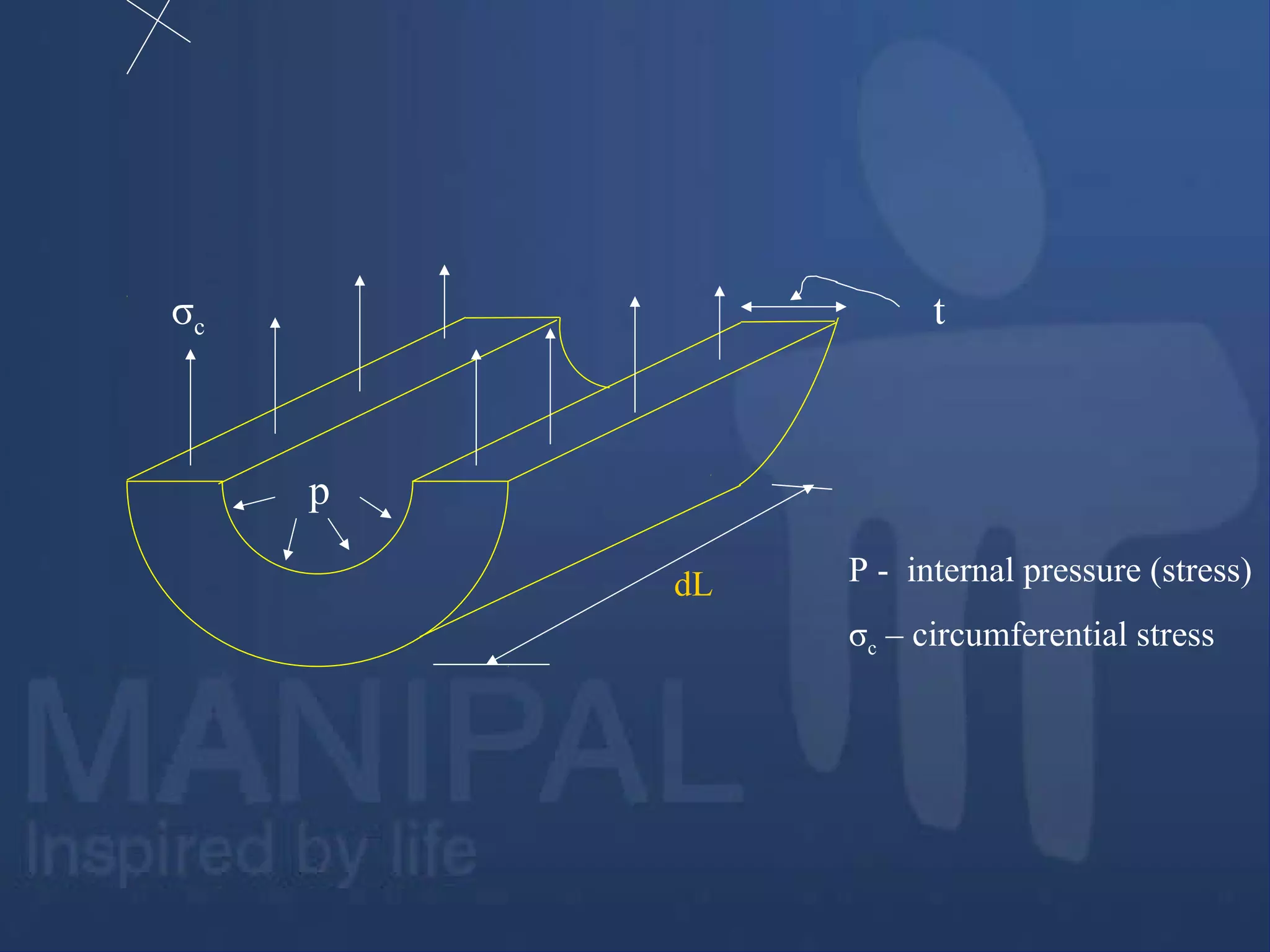


![The horizontal components cancel out
when integrated over semi-circular
portion as there will be another equal
and opposite horizontal component on
the other side of the vertical axis.
sin
2
d
pforceburstingldiametricaTotal
0
∫ ××××=∴
π
θ dθdl
dA
σcσc
dlt
p
θ
d
dθ
[ ]
surface.curvedtheofareaprojectedp
dpcosdl
2
d
p 0
×=
××=−×××= dlπ
θ](https://image.slidesharecdn.com/thinandthickcylinders-180511185429/75/Thin-and-thick-cylinders-10-2048.jpg)





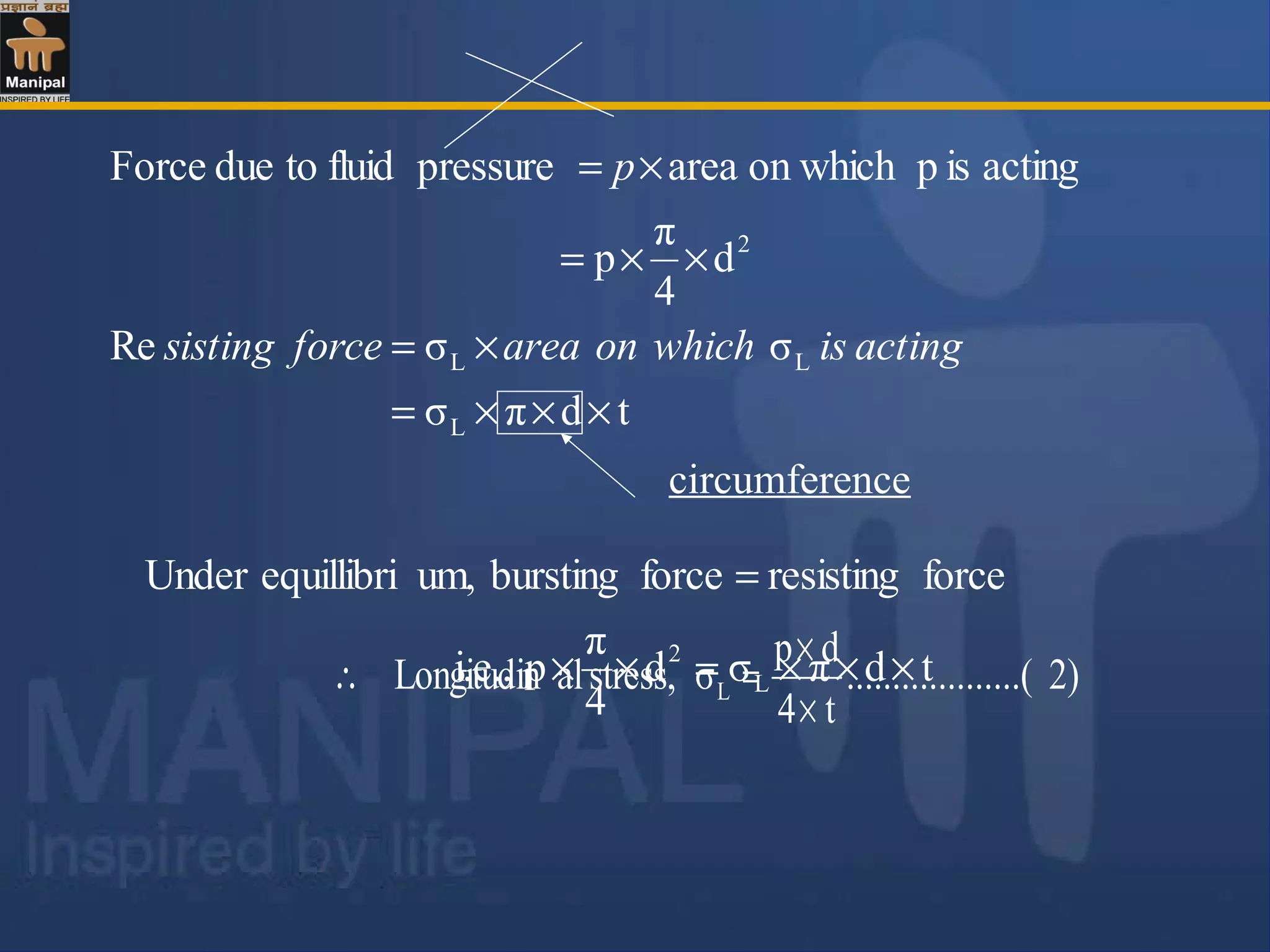
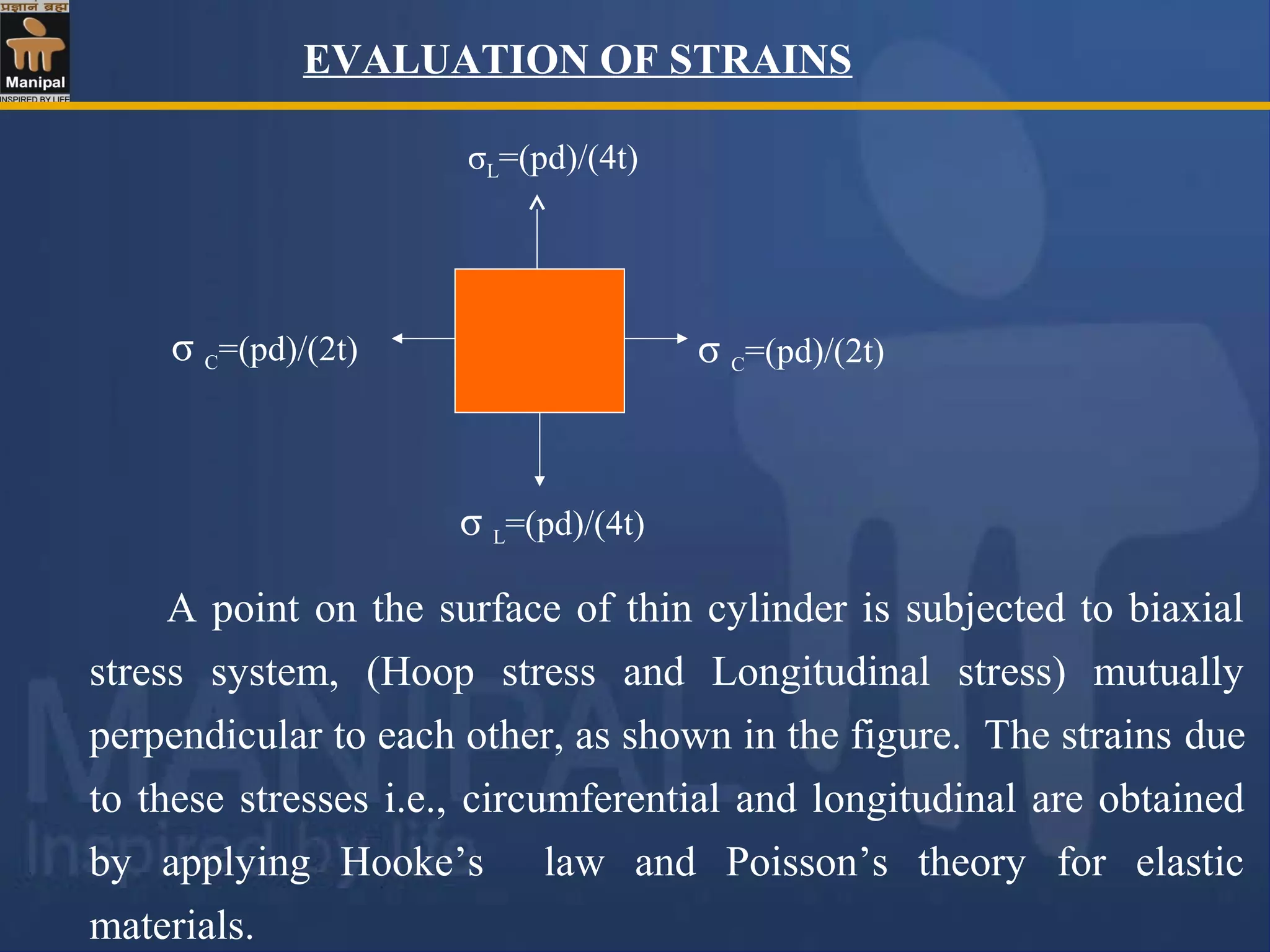
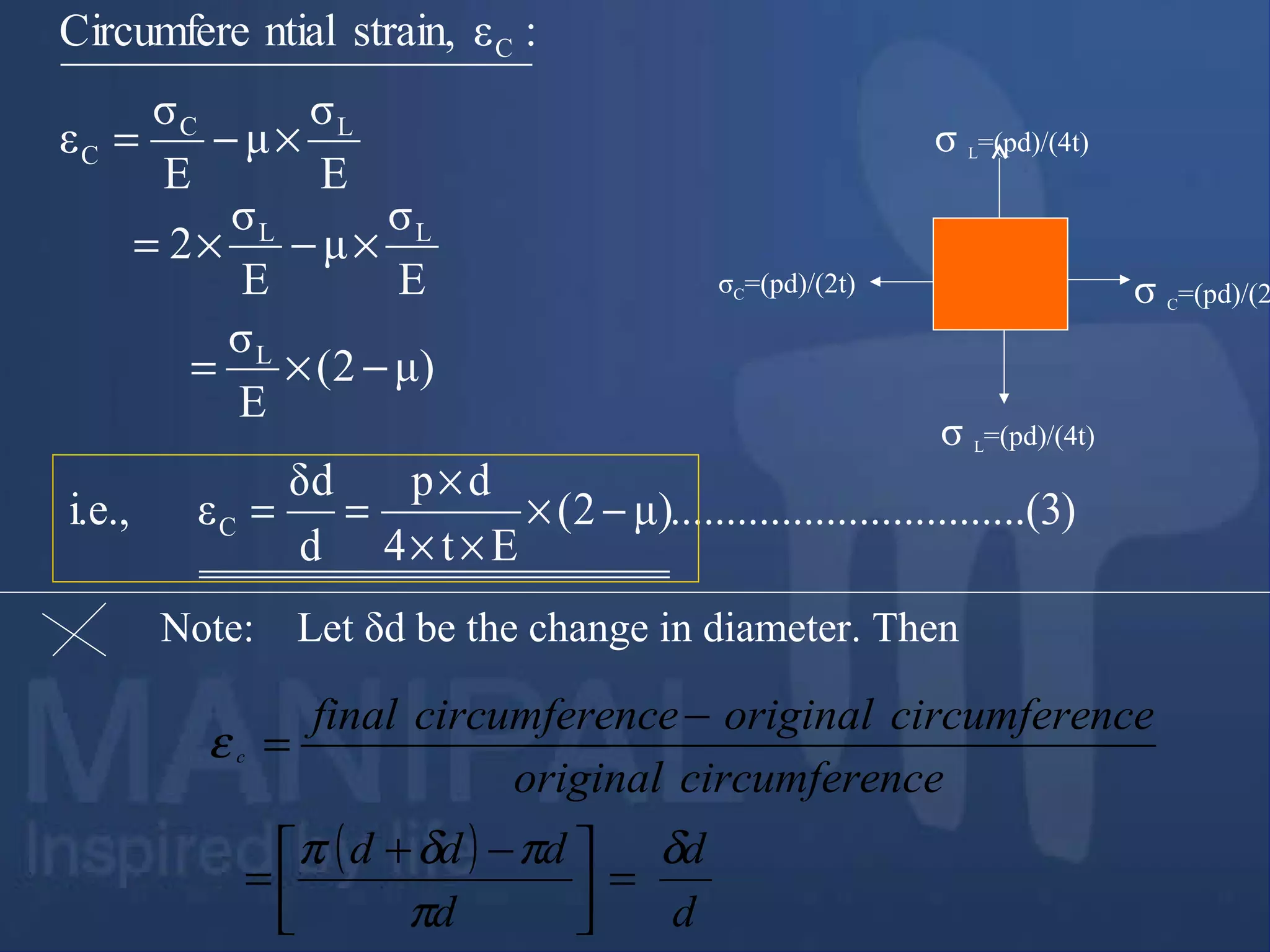
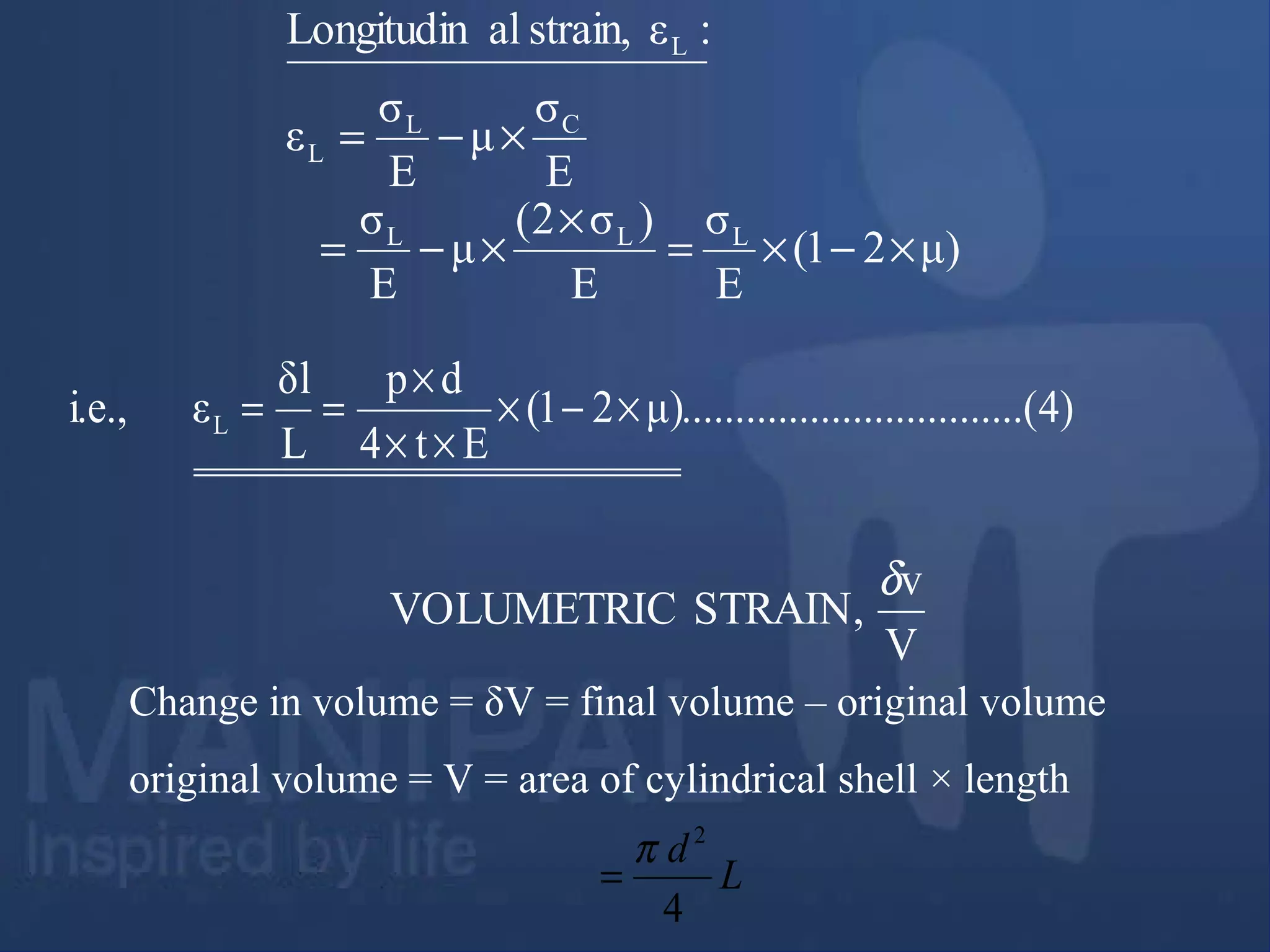
![final volume = final area of cross section × final length
[ ] [ ]
[ ] [ ]
[ ]LddLdLdddLLdLd
LLdddd
LLdd
δδδδδδδ
π
δδδ
π
δδ
π
2)(2)(
4
2)(
4
4
2222
22
2
+++++=
+×++=
+×+=
[ ]LdddLLdvolumeFinal
LddandLdLdassuchquantitiessmallertheneglecting
δδ
π
δδδδδ
22
22
2
4
2)(,)(
++=
[ ] [ ]
[ ]LdddLV
LdLdddLLdVvolumeinchange
δδ
π
δ
π
δδ
π
δ
2
222
2
4
4
2
4
+=
−++=](https://image.slidesharecdn.com/thinandthickcylinders-180511185429/75/Thin-and-thick-cylinders-20-2048.jpg)
![[ ]
Ld
4
π
2
4
π
V
dv
2
2
××
+
=
dLdLd δδ
= εL + 2 × εC
V
dV
)5.......(..........μ)45(
Et4
dp
V
dv
i.e., ×−
××
×
=
μ)2(
Et4
dp
2μ)21(
Et4
dp
−
××
×
×+×−
××
×
=
d
d
2
L
L δδ
×+=](https://image.slidesharecdn.com/thinandthickcylinders-180511185429/75/Thin-and-thick-cylinders-21-2048.jpg)





![A copper tube having 45mm internal diameter and 1.5mm wall
thickness is closed at its ends by plugs which are at 450mm apart. The
tube is subjected to internal pressure of 3 MPa and at the same time
pulled in axial direction with a force of 3 kN. Compute: i) the change
in length between the plugs ii) the change in internal diameter of the
tube. Take ECU = 100 GPa, and μCU = 0.3.
A] Due to Fluid pressure of 3 MPa:
Longitudinal stress, σL = (p×d) / (4×t)
= (3×45) / (4× 1.5) = 22.50 N/mm2
= 22.50 MPa.
SOLUTION:
Change in length, δL= εL × L = 9 × 10-5
×450 = +0.0405 mm (increase)
E
)μ21(
t4
d)(p
εstrain,Long. L
×−
×
×
×
=
5
3
109
10100
)3.021(5.22 −
×=
×
×−×
=](https://image.slidesharecdn.com/thinandthickcylinders-180511185429/75/Thin-and-thick-cylinders-27-2048.jpg)
![Change in diameter, δd= εc × d = 3.825 × 10-4
×45
= + 0.0172 mm (increase)
B] Due to Pull of 3 kN (P=3kN):
Area of cross section of copper tube, Ac = π × d × t
= π × 45 × 1.5 = 212.06 mm2
Longitudinal strain, ε L = direct stress/E = σ/E = P/(Ac × E)
= 3 × 103
/(212.06 × 100 × 103
)
= 1.415 × 10-4
Change in length, δL=εL× L= 1.415 × 10-4
×450= +0.0637mm (increase)
E
)μ2(
t)(4
d)(p
εstrainntialCircumfere C
−
×
×
×
=
Pd/4t = 22.5
4
3
10825.3
10100
)3.02(5.22 −
×=
×
−×
=](https://image.slidesharecdn.com/thinandthickcylinders-180511185429/75/Thin-and-thick-cylinders-28-2048.jpg)


